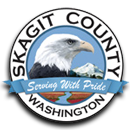|
Introduction:
Skagit County's Salmon Policy Resolution (R20070499) directs the county's
Geographic Information Systems department to undertake a significant mapping
project of riparian areas on agricultural and natural resource lands within
the Skagit River watershed. Some 770 miles of watercourse are included.
The study area does not include areas outside Skagit County's jurisdiction
(cities and towns), diking and drainage districts covered by the Drainage
and Fish Initiative and the Tidegate and Fish Initiative agreements, and
type 5 streams.
Background
Many counties protect streams using mandatory buffers strips of land bordering
the stream where development or farming is not allowed. Because buffers
can impose a heavy burden on agriculture, Skagit County does not require
buffers on ongoing agricultural lands.
Project Goal
The project's goal was to measure the amount of existing vegetated riparian
area and compare it to the amount of potential vegetated riparian area
if buffers were required along the watercourses. The project essentially
attempted to answer the question, "How much riparian area is already
protected on lands with ongoing ag?"
Methodology
The project used high-resolution bird's eye aerial photography that allowed
easy identification of vegetation type and accurate identification of
even narrow buffers less than 30-feet. For still more precision, project
staff used LIDAR imagery that measured vegetation height. With both types
of imagery at their disposal, GIS staff examined each watercourse and
its surrounding area by hand for accurate ground cover assessment.
Results
Of the 8,031 acres of standard buffer area analyzed, we classified the
following land uses: 22% agriculture, 5% developed land or road covered,
and 73% forest, wetland, or natural grass. Agricultural activity varied
by region ranging from 13% in the Sauk region to 35% in the Nookachamps.
One purpose of this
study was to determine how many acres of riparian agricultural land would
be eligible for habitat protection. For agricultural use areas within
standard buffer areas (1,766 acres), we concluded that there are 42 acres
of protected land, 75 acres of public land, and 64 acres of land with
no functions or values. Together, these three categories, which would
not qualify for habitat acquisition programs, constitute 10% of the agricultural
land studied within the standard buffer area. Of the remaining agricultural
area, 90% is potentially restorable.
We also compared our
land use data with other compiled satellite data sets. These other studies
used an automated processing of land cover and have a course resolution
of only 30 meters, which detects only large-scale patterns. During this
analysis, we found that the high-resolution photography detected many
clues and cover types that the 30-meter data set did not detect. In comparison
with our study, both course resolution studies over-estimated agricultural
land use-NLCD by 123% and RTI by 289%.
Expected Use of
Results
Beyond its applications for the Ruckelshaus Center process, Skagit County
intends to use the results of this project to evaluate the severity of
the riparian protection situation, and to prioritize and focus efforts
to enhance riparian areas.
Riparian
Mapping Project Summary and Conclusions (Pdf)
White
Paper (Pdf)
For more information,
please contact:
Josh Greenberg, PhD.
Skagit County GIS/Mapping
360-416-1168 · joshg@co.skagit.wa.us
|







